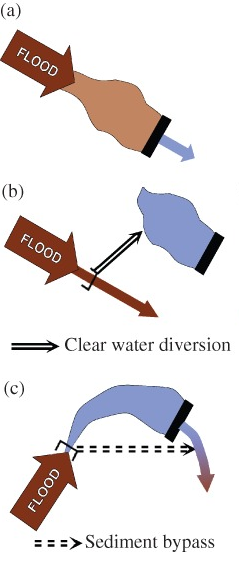Mechanical removal of fine sediments (dredging)
Contents
Introduction

Changes in land-use has strongly modified the sediment yield to rivers and led to high to extreme sediment suspended load in some rivers. The exceed of fine sediment might deposit in the river, and particularly in the bed interstices, depending on the velocity and discharge in the river at the time of sediment arrival. Similarly, in some rivers, regulation has strongly reduced the flow while sediment yield has not been altered, leading to an exceed of fine sediments in the river and deposition on the bed. Therefore, fish habitat might be strongly altered and affected by an increase in water turbidity and clogging of substrate (see Chapter 5.5).
Methods, tools, and devices
During planning
Fine sediments suction induced by removal might affect spawning and larval habitats of species living in the area where removal is planned. Therefore, a control of fish species living in the area, and possibly a fish population survey, should be realized prior to any removal (Gray 2013). Site preparation for removal might also generate resuspension of sediments in the removal area and induce transport of significant sediment loads downstream the site accompanied with peaks of turbidity. Access to the river bank and adapted movements around the removal site are simple measures to integrate to the overall planning of fine sediments dredging.
During implementation
The equipment for sediment removal is a pump. The capacity of the pump is determined by the amount of water to pump, the sediment quantities to be removed and the location of water and sediment releases.
During operation
Fine sediment removal induces disturbing of sediments that will be mostly pumped and released out of the stream. However, some of the remobilized sediments might be transported further downstream and induce an increase of water turbidity and possibly re-deposition at another location. Water clarity, as well as measurement of suspended sediment concentration is recommended to evaluate the possible effects of the removal.
Classification table
|
Classification
|
Selection (multiple) |
|
|
Fish species measure designed for |
All |
|
|
Does the measure require loss of power production? |
Structural (requires no additional flow release) |
|
|
Recurrence of maintenance |
irregular at events |
|
|
Which life-stage of fish is measure aimed at? |
All |
|
|
Which physical parameter mitigated? |
Substrate and hyporheic zone |
|
|
Hydropower type the measure is suitable for |
Plant in dam Plant with bypass section |
|
|
Dam height [m] the measure is suitable for |
All |
|
|
Section in the regulated system measure is designed for |
All |
|
|
River type implemented |
All |
|
|
Level of certainty in effect |
Very certain |
|
|
Technology readiness level |
TRL 9 |
actual system proven in operational environment |